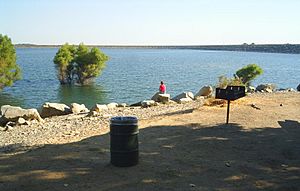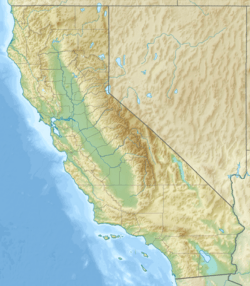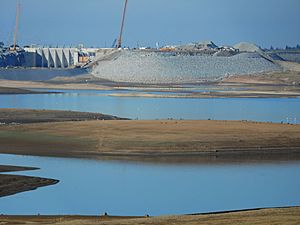Folsom Lake facts for kids
Quick facts for kids Folsom Lake |
|
|---|---|

Folsom Lake in 2006
|
|
| Location | Northern California |
| Coordinates | 38°44′N 121°08′W / 38.73°N 121.14°W |
| Type | Reservoir |
| Primary inflows | American River |
| Primary outflows | American River |
| Basin countries | United States |
| Surface area | 11,450 acres (4,630 ha) |
| Water volume | 976,000 acre-feet (1.204×109 m3) |
| Dam | Folsom Dam |
Folsom Lake is a reservoir on the American River in the Sierra Nevada foothills of California, United States.
It is located within Placer, El Dorado, and Sacramento counties. It is about 25 mi (40 km) northeast of Sacramento. The lake surface area is 11,500 acres (46.54 sq. km), its elevation is 466 ft (142 m) and it has 75 mi (121 km) of undulated shoreline. Folsom Lake and the surrounding Folsom Lake State Recreation Area is one of the most visited parks in the California Park system.
The California Office of Environmental Health Hazard Assessment (OEHHA) has developed a safe eating advisory for Folsom Lake based on levels of mercury found in fish caught here.
History
The Folsom Lake reservoir is formed by Folsom Dam, built in 1955 to control and retain the American River. The dam and reservoir are part of the Folsom Project, which also includes the Nimbus afterbay reservoir and dam facilities. The Folsom Project, operated by the United States Bureau of Reclamation, is part of the Central Valley Project, a multipurpose project that provides flood control, hydroelectricity, drinking water, and water for irrigation.
When the dam was built, it was designed to hold 976,000 acre-feet (1,204,000 dam3) with a surface area of 11,450 acres (4,630 ha). The dam is 1400 feet wide and 340 feet high. It is a concrete structure with approximately 9 miles of earth fill wing dams and dikes supporting its surrounding areas.
During the drought of late 2013, part of the 2012–14 North American drought, the town known as Mormon Island reappeared 58 years after being submerged under Folsom Lake, with stone walls from some of the outlying areas being revealed by the shrinking lake.
Folsom Lake State Recreation Area
The Folsom Lake State Recreation Area (SRA) surrounds the reservoir, and is managed by the California Department of Parks and Recreation. The lake supports a large number of recreational activities. Aquatic activities account for 85% of all recreation visits to the SRA. Areas are designated for hiking, camping, and biking. The lake is also commonly used for fishing, boating, water-skiing, and horseback riding.
The majority of the SRA is owned by the US Department of the Interior Bureau of Reclamation, and the area is managed by the state parks.
Two major freeways feed access to the SRA, Highway 80 and Highway 50. A number of local roadways, trails, and public transportation routes access the SRA. Six key roadways that access the SRA are Douglas Boulevard, Auburn/Folsom Road, Folsom Boulevard, East Natoma Street, Green Valley Road, and Salmon Falls Road. The most recognized regional trails are Jedidiah Smith Memorial Trail and Pioneer Express Trail. The public transport that accesses the SRA include Placer County Transit, Folsom Stageline, Roseville Transit and Sacramento Regional Transit.
The recreation area is located at the union of the north and south forks of the American River. There are 20,000 acres of water and land within the boundaries of the SRA. The State Recreation Area spans El Dorado, Placer, and Sacramento counties, as well as the City of Folsom.
The fishing is tough due to the always rising and falling water levels of the lake. Fish species include largemouth bass, smallmouth bass, spotted bass, rainbow trout, Kokanee salmon, catfish, sunfish, squawfish, and carp.
There are five major day use areas on the lake, Granite Bay, Beales Point, Folsom Point, Negro Bar, and Nimbus Flats.
Granite Bay and Beals Point are the primary visitor areas on the western shoreline of Folsom Lake, with large day-use areas that include swim beaches, boat launch facilities, restrooms, landscaped picnic areas, snack food and beach equipment concessions, trailheads and associated parking. The Granite Bay facility includes a multi-use activity center which is available to rent and the Beals Point includes a 69-site campground. The smaller and more remote rattlesnake Bar visitor area provides boat launch facilities and informal access to the shoreline for fishing, swimming and picnicking.
The eastern shoreline is home to Brown’s Ravine and Folsom Point. Brown’s Ravine includes the Folsom Lake Marina which provides 675 wet slips, 175 dry storage spaces, boat launch areas, marine provisions and fueling stations, small picnic area, and restrooms. Folsom Point includes a picnic area, boat launch, and restrooms.
Facilities at these locations include swim beaches, picnic areas, food and beach equipment concessions, equestrian staging areas, restrooms and drinking water fountains, and trail heads with over 94 miles of trails (utilized by hikers, runners, mountain bikers, and horseback riders).
Wildlife
California buckeye, blue oak, valley oak, digger pines, black oaks and occasionally oracle oaks populate the area surrounding the lake. A variety of wildflowers thrive in the Spring, Indian paintbrush, California poppy, larkspur, lupine, bordicaea, fiddleneck, Dutchman's pipe and monkey flower can be seen throughout the SRA.
A number of mammals inhabit the lake area including, coyotes, gray foxes, rabbits, skunks, raccoon, ground squirrels, black-tailed deer, opossums, and on occasion mountain lions, bobcats, and black bears have been sighted.
A number of birds call Folsom Lake home year round, bushtits, quails, wrens, scrub jays, black birds and towhees. Near the water visitors often see kingfishers, red-tailed hawks, eagles, kestlers, gulls and other raptors looking for a meal.
Flood control
For eight months of the year, October 1 through May 31, the dam and lake is utilized to prevent flooding on the lower end of the American River. The Sacramento basin is notorious for flooding and the dam helps relieve winter storm runoff and snow melt from the Sierra.
It is a major component of the American River Watershed. During the summer months, water is released to prevent salt water intrusion in the San Joaquin Delta. These releases maintain water quality and keep ideal water temperatures for anadromous fish species such as Chinook salmon, steelhead and American shad. Several of these species are of primary concern due to their decline in numbers and spawning habitat destruction.
Water in Lake Folsom is also utilized for drinking water and power generation throughout the year. As a reservoir, the water levels in the lake fluctuate between 440 feet in the early summer and 405 feet in the early winter. In drought years, the water levels can be drawn below 400 feet in elevation. Some of the factors that affect these levels include precipitation, downstream flows and fishery needs.



